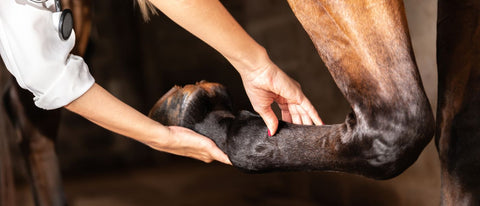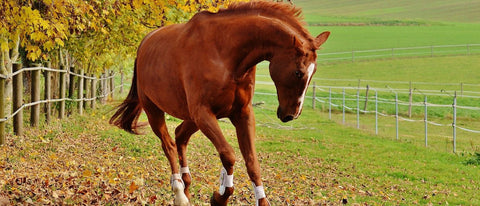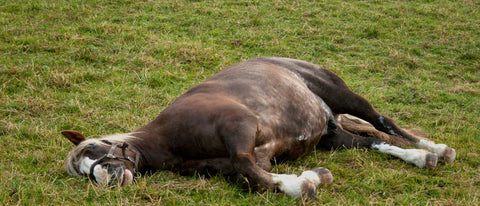
Florian ist aufgewachsen auf einem Bauernhof. Umgeben von Pferden, entdeckte er früh seine Faszination für diese majestätischen Tiere. Inspiriert von seiner reitbegeisterten Mutter, entwickelte er das Nahrungsergänzungmittel - Pferdegold. Seine tiefe Verbundenheit zur Natur und die leidenschaftliche Hingabe zu Pferden trieben ihn an, sein Unternehmen zu gründen.
Horseshoes protect hooves from wear and damage – especially during intensive use and on hard surfaces. Targeted hoof protection is essential – whether used in training, at competitions, or in everyday life.
Modern horseshoes not only provide protection but also correct hoof misalignments, thus supporting your horse's health. Regular hoof care and inspection are essential to ensure long-term increased performance and mobility.
Do horses need horseshoes?
Horseshoes play an important role in daily hoof protection . They prevent excessive wear and tear on the hooves and protect against damage that can occur, for example, on rough, hard or uneven surfaces. At the same time, they offer
- improved stability
- and support in correcting minor hoof or gait problems.
Not all horses need horseshoes – the decision is made individually, based on the natural hoof condition, use and ground conditions.
For horses that are used exclusively on soft, natural ground , a barefoot lifestyle may be sufficient . On the other hand, sport and working horses often benefit better from additional protection.

The history and development of horseshoeing
The history of horseshoes stretches back a long way. Archaeological finds from Celtic graves indicate that the first forms of horseshoes existed many centuries ago. The first reliable evidence of nailed horseshoes dates back to around 1000 AD.
In the late Middle Ages, horseshoes with handles and special studs, handcrafted by farriers, became popular. Today, machine-made versions are commonplace—they fit precisely and are available in various shapes to suit your horse's individual needs.
Materials and production of modern horseshoes
Modern horseshoes are predominantly made of high-quality wrought iron . The specific carbon content—usually between 0.2% and 0.5%—enables an optimal balance between strength and flexibility.
During the forging process, the horseshoes are heated to temperatures of approximately 800°C to 1200°C, which gives them their characteristic shape.
Different shapes and sizes are available for different applications and horse types . Special products such as orthopedic horseshoes are used especially when it comes to
- to correct misalignments
- or to specifically counteract existing hoof problems.
Advantages and disadvantages of horseshoeing
To help you better understand the decision between conventional horseshoeing and alternative methods (such as hoof boots or barefoot styling), we have summarized the most important advantages and disadvantages in a clear table:
|
Advantages |
Disadvantages |
|
Protection against excessive wear |
Can increase joint stress |
|
Possibility to correct Hoof malpositions |
Increased risk of injury if improperly installed |
|
Improved grip on certain surfaces |
Restriction of natural hoof mechanics |
Choosing the right solution depends on your horse's individual needs. Incorrectly fitted horseshoes, for example, can cause pain —correct application by a qualified farrier is therefore essential.
Horse shoeing and hoof care
A key aspect of using horseshoes is regular care . Since hooves are constantly renewing themselves, the shoeing should generally be checked every 6–8 weeks and replaced if necessary. Even horses that are not shod benefit from regular hoof care.
An experienced farrier checks the hooves regularly and smooths out any unevenness . Good hoof care contributes significantly to your horse's long-lasting hoof stability .
In addition, targeted care with high-quality products such as Pferdegold Hufe supports natural hoof growth – both through external applications such as greasing the hooves and through targeted nutrient supply from within.

Pferdegold® Hooves
If your horse has dry and brittle hooves, it can benefit from a balanced supply of nutrients such as zinc, manganese, copper, and biotin. This dietary supplement provides your horse with important nutrients to support the regeneration of hooves, coat, and skin.
Order nowSpecial features of different horse breeds: Not all horseshoes are the same
The need for and type of shoeing varies greatly between different horse breeds and intended use . Sport and working horses regularly require appropriate shoeing. For disciplines such as
- dressage riding,
- Jump,
- western
- or gaited horse riding, there are special horseshoes that meet the requirements of the respective sport.
Some breeds naturally have particularly robust hooves, which often prove themselves even without additional shoeing.
Others, such as warmbloods , benefit from the targeted support provided by horseshoes .
Corrective shoeing: Health aspects of using horseshoes
The selection and correct use of horseshoes can play a decisive role in preventing or reducing hoof problems . Correct shoeing
- supports natural hoof growth
- and prevents harmful influences that can lead to cracked horn or poor hoof structures.
However, incorrectly fitted horseshoes can also have negative effects – such as lameness or pain.
The decision as to whether and which horseshoes should be used should therefore always be made in consultation with a competent veterinarian or an experienced hoof specialist.

Conclusion
In summary, horseshoes provide important protection for your horse's hooves, help correct misalignments, and contribute to increasing performance.
The right selection, regular care, and professional application are crucial. Each case is unique, which is why close cooperation with experienced farriers and veterinarians is recommended.
FAQ
Why do horses need horseshoes?
Horseshoes protect hooves from wear, support hoof growth, and can help correct misalignments. They are especially important for horses that are moved on hard or uneven surfaces.
How often does a horse need to be shod?
It is usually sufficient to check the hooves every 6–8 weeks and reshoe them if necessary. However, this also depends on individual hoof growth and wear.
What happens if a horse goes without horseshoes?
Horses that live without shoes still require regular hoof care. If their hooves are sufficiently robust, shoeing is not absolutely necessary; however, continuous monitoring is essential to prevent hoof problems.
Do horses experience pain from horseshoes?
It's important that horseshoes are fitted professionally. Correctly fitted horseshoes shouldn't cause pain. However, incorrectly fitted horseshoes can cause discomfort, so an experienced farrier should always work on them.
Why don't wild horses need horseshoes?
Wild horses live on natural, often soft ground and develop accordingly
Robust hooves that require no additional protection. Natural wear keeps the hooves in optimal condition.
Important:
Pferdegold is not a substitute for veterinary diagnosis or treatment. The information contained in this article is for general informational purposes only and is intended to help improve your horse's well-being.
Pferdegold products do not treat or cure diseases, but rather support your horse in compensating for nutritional deficiencies through targeted nutrient intake.
However, they are not a substitute for professional advice from a veterinarian or specialist. If your horse has any health problems, we strongly recommend consulting a veterinarian. Pferdegold assumes no liability for decisions made based on the information provided here.

















